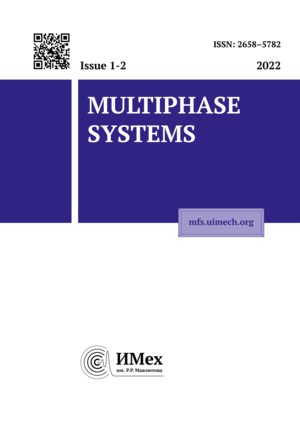Khabirov S.V.
The main tasks of group analysis of differential equations of mechanics. Multiphase Systems. 17 (2022) 1–2. 51–62 (in Russian).
The main tasks of group analysis of differential equations of mechanics
Khabirov S.V.
Mavlyutov Institute of Mechanics UFRC RAS, Ufa, Russia
Abstract
Group analysis of differential equations uses the Lie theory of correspondence between continuous transformation
groups and Lie algebras of first-order differentiation operators. Differential equations of mechanics necessarily admit
an extensive group of transformations. Lie theory studies the structure of the algebra of this group. The group
analysis of the equations of mechanics uses the structure of the admissible algebra to produce submodels and exact
solutions, to study the boundary value problems of submodels and the behavior of the mechanical medium for exact
solutions. The main tasks of group analysis are formulated and simple examples of their solutions are given.
Keywordsequations of mechanics,
group analysis,
lie theory,
submodels,
exact solutions
Article outline
Objective: to describe the main modern problems of group analysis of differential equations of mechanics. All tasks are divided into 4 large sections: permissible group and group classification, structure of permissible groups, stratification and submodels, and other group analysis tasks.
In the first section, the first three main sequential problems are formulated and solutions to these problems are given by the example of equations of one-dimensional gas dynamics with plane waves.
In the second section, two more problems are presented and an example of the kernel of admissible algebras for one-dimensional gas dynamics is considered.
In the third section, three more tasks with examples are formulated.
In the fourth section, other tasks of group analysis are formulated. Methods for solving some problems are well developed, but for some there may be no algorithmic approaches.
Result: the article lists 13 new problems of group analysis of differential equations of mechanics. For the first 8 tasks, the simplest examples of the implementation of these tasks are given. The other five tasks are announced with links to ways to solve them.
Conclusions: the group analysis of differential equations of mechanics contains many more unsolved problems.
References
- Ovsannikov L.V. The submodel program. Gaz dynamika // PMM. 1994. Vol. 58., № 4. Pp. 30–55. (in Russian)
- Mukminov T.F., Khabirov S.V. Graph of nested subalgebras of the 11-dimensional algebra of continuum symmetries // Siberian Electronic Mathematical News. 2019. Vol. 16. Pp. 121–143. (in Russian)
DOI: 10.33048/semi.2019.16.006
- Ovsannikov L.V. Some problems arising in the group analysis of differential equations // Dynamics of a continuous medium / Academy of Sciences of the USSR, siberian branch, Institute of Hydrodynamics. Novosibirsk, 1974. Vol. 18. Pp. 211–238. (in Russian)
- Ovsannikov L.V. Group analysis of differential equations. M.: Science. 1978. 399 p. (in Russian)
- Ovsannikov L.V. Lectures on the basics of gas dynamics. M. Igevsk: Institute of computer research. 2003. 336 p. (in Russian)
- Khabirov S.V. Infinite continuous groups of transformations of three-dimensional space defined by systems of first-order differential equations // Dynamics of a continuous medium. Novosibirsk: Institute of Hydrodynamics SB RAS. 1972. Vol. 12. Pp. 131–146. (in Russian)
- Ovsannikov L.V.On infinite groups of maps given by differential equations // Reports of the USSR Academy of Sciences. 1963. Vol. 148, № 1. Pp. 36–39. (in Russian)
- Ovsannikov L.V. Group stratification of boundary layer equations // Dynamics of a continuous medium. 1969. Vol. 1. Pp. 24–36. (in Russian)
- Chirkunov Y.A. Group stratification of the Lame equations of the classical dynamic theory of elasticity // Izvestia AN. Solid state mechanics. 2009. Vol. 426, № 5. Pp. 605–607. (in Russian)
- Ovsannikov L.V. Regular and irregular partially invariant solutions // Dokl. RAS. 1995. Vol. 343, № 2. Pp. 156–159. (in Russian)
MathNet: dan4403
- Khabirov S.V. Classification of differentiall invariant submodels // Siberian Mathematical Journal. 2004. Vol. 45, № 3. Pp. 562–579.
DOI: 10.1023/B:SIMJ.0000028621.02366.bf
- Ibragimov N.H. A new conservation theorem // Journal of Mathematical Analysis and Application. 2007. Vol. 333, No 1. Pp. 311–328.
DOI: 10.1016/j.jmaa.2006.10.078
- Chirkunov Y.A. Method of A-operators and conservation laws for the equations of gas dynamics // Journal of Applied Mechanics and Technical Physics. 2009. Vol. 50. Pp. 213–219.
DOI: 10.1007/s10808-009-0029-7
- Khabirov S.V, Chirkunov Y.A. Elements of symmetric analysis of differential equations of continuum mechanics. Novosibirsk: NSTU. 2012. 659 p. (in Russian)
- Khabirov S.V. On conservation laws for a viscous liquid // Proceedings of the Mavlyutov Institute of Mechanics. Т. 12 (2017), № 1. С. 40–43. (in Russian)
DOI: 10.21662/uim2017.1.006
- Ibragimov N.H. Transformation Groups to Mathematical Physics. Moscow: Nauka, 1983. 280 с. (in Russian)
- Khabirov S.V The Backlund problem for second-order evolutionary equations / Preprint of the BFAN USSR. Ufa. 1986. 35 p. (in Russian)
- Khabirov S.V. Group analysis of the plane steady submodel of ideal gas with varying entropy // MDPI. Mathematics. 2021. V. 9, issue 16. Pp. 1–15.
DOI: 10.3390/math9162006
- Menshikov V.M. On the continuation of invariant solutions of gas dynamics equations through a shock wave // Dynamics of a continuous medium. Vol. 4. Novosibirsk. 1969. Pp. 163–169. (in Russian)
- Menshikov V.M. On the continuous conjugation of invariant solutions // Dynamics of a continuous medium. Vol. 10. Novosibirsk. 1972. Pp. 70–84. (in Russian)
- Pukhnachev V.V. Unsteady motions of a viscous fluid with a free boundary described by partially invariant solutions of the Navier-Stokes equations // Dynamics of a continuous medium. Vol. 10. Novosibirsk. 1972. Pp. 125–137. (in Russian)
eLIBRARY ID: 37264575
- Khabirov S.V. Self-similar convergence of a shock wave in a heat conducting gas // Journal of Applied Mathematics and Mechanics. 2009. Vol. 73, Issue 5. Pp. 524–531.
DOI: 10.1016/j.jappmathmech.2009.11.005
- Baikov V.A., Gazizov R.K., Ibragimov N.H. Approximate groups of transformations // Partial Differential Equations. Vol. 29, No. 10. (1993). Pp. 1487–1504.
MathNet: de8212
- Khabirov S.V. Classification of three dimensional Lie algebras in R3 and their differential invariants // Lobachevskii Journal of Mathematics. 2010. V. 31, No. 2. Pp. 152–156.
DOI: 10.1134/S199508021002006X


